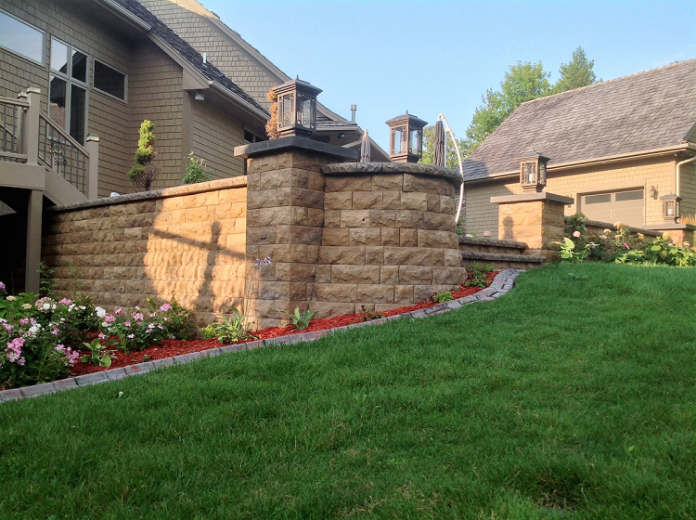When it is time to update the yard, one of the most popular additions that homeowners prefer is none other than a stone retaining wall. While this masonry may seem like a simple stacked stone, it is actually a carefully engineered system that defies gravity. This handsome barrier can also be designed in a number of ways, including a conventional wall to create a covered yard or a series of low steps, tiers or terraces that can double as planting beds.
A stone retaining wall can either be dry-stacked or mortared. When referring to dry stacking, the pieces of stone are evenly put in place without using a mortar, but their voids are filled with dirt that helps keep the wall stable. A mortared stone retaining wall, on the other hand, uses mortar or grout to hold the stone in place.
When you have a stone retaining wall in your yard, you not only have a long lasting structure that could enhance the appearance of your outdoor space. You also have a structure that can enhance the function of your yard and eliminate many of its problems in a number of ways. Below are some of the good things that a well-built stone retaining wall can do to your yard.
Creates a simple yet beautiful enclosure
A well-constructed stone retaining wall makes for a naturally stylish barrier for your yard, which at the same time can function as a major focal point in the landscape. It easily blends well to its surroundings given that it is made from a natural material. As such, it will not deviate from the look of yard, but rather further enhance its appearance, while offering you sufficient privacy.
The great thing about a stone retaining wall is that there are no strict guidelines for setting the stones. That means, you can style it in such a way you prefer and still achieve a beautiful stone enclosure. For instance, if you want a stylish barrier for your yard, you can create a dry-stacked undulating fieldstone retaining wall. A straight wall, on the other hand, makes for a great option if you have limited space to work with.
Increase usable yard space
As noted earlier, you can design a stone retaining wall into a series of steps, tiers or terraces. When done this way, the retaining wall does more than create a clear barrier along a property line. It can also add textural visual interest to your landscaping and even increase the usable space in your yard. The steps, tiers or terraces make for inviting spots where you and guests can sit and can also double as planting beds where you can exercise your green thumbs.
In downhill areas or steep slopes, retaining walls, when designed in the form of terraces, can transform these spaces into usable living areas. This is increasingly becoming important as flat sites for homes are becoming scarcer in numerous regions.
Offers protection against soil erosion
Perhaps the most important function that a stone retaining wall can impart to your yard is that it can control, if not eliminate, the problems of runoff, flooding and soil erosion within the space.
Take note that heavy rains can bring about runoffs that can easily damage your surrounding landscape and cause an exposed bank of soil to crumble. Constructing a stone retaining wall can help stabilize these situations. In the case of a runoff, tiered or terraced retaining walls can help slow down the flow of water into the yard. When the tiers or terraces are used as planting beds, rain will be absorbed by the soil instead of flowing directly to the rest of the landscape, preventing damage to surrounding plants and flooding.
As for soil erosion, a stone retaining wall helps resolve the issue by correcting the topography of the soil. As it levels steep slopes and cover up exposed bank of subsoil, the wall keeps tons of saturated soil in place that would otherwise slide away during heavy rains or strong winds.
A word on installing stone retaining wall
There is no doubt that a stone retaining wall is more than just a cosmetic addition for your yard. It is also a structure that can be used to increase usable space in an otherwise sloped area and greatly addresses the issues of runoff, flooding and soil erosion. However, it should be noted that the performance of a stone retaining wall largely depends on the way it was built. If you want to ensure that you will get the performance you are expecting from your stone retaining wall, be sure to build it right by having a proper drainage in place, digging the right depth and using the right materials during its construction.
Jessie Moore is a fulltime writer with a strong interest in masonry. Her interest in the said subjects inspires her to write helpful posts related to masonry construction, repair and maintenance. She also contributes content for McIntyre Stonemasonry in Edinburgh.


















